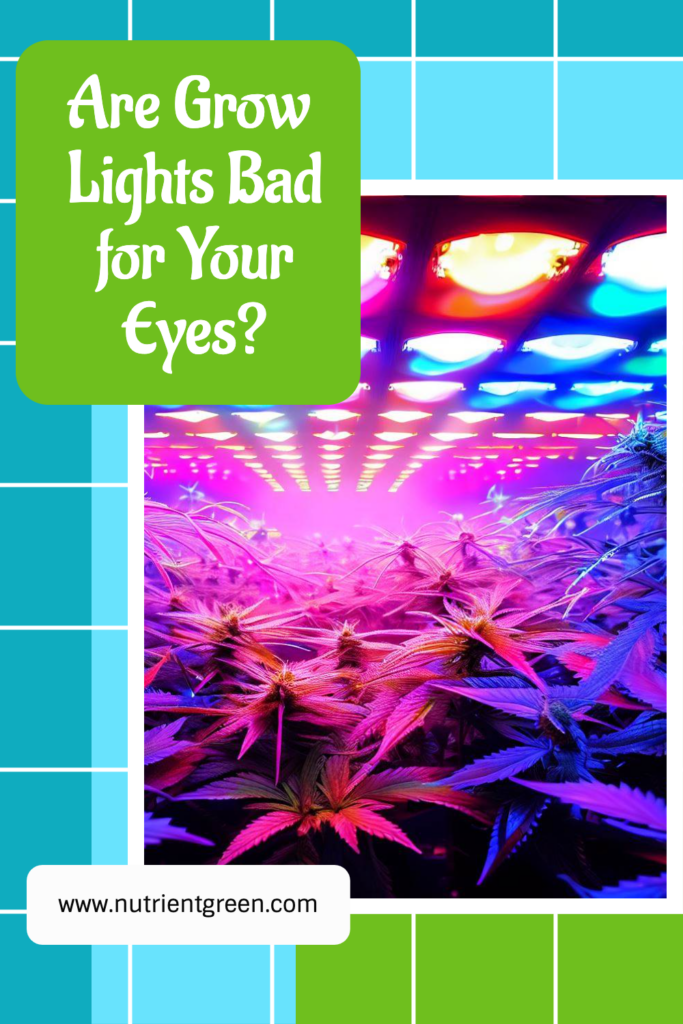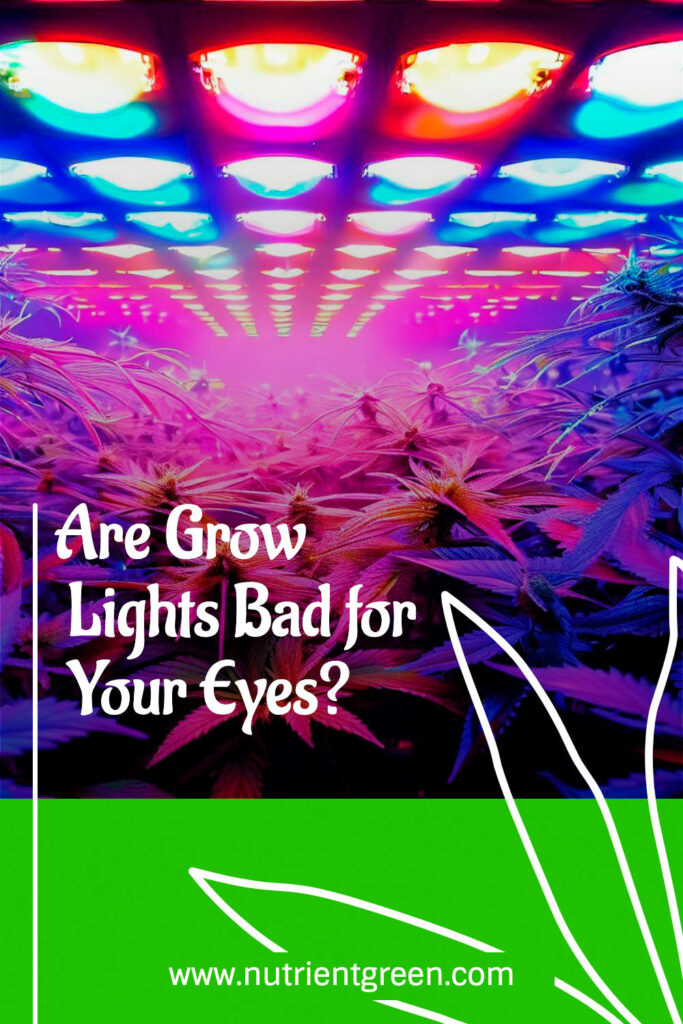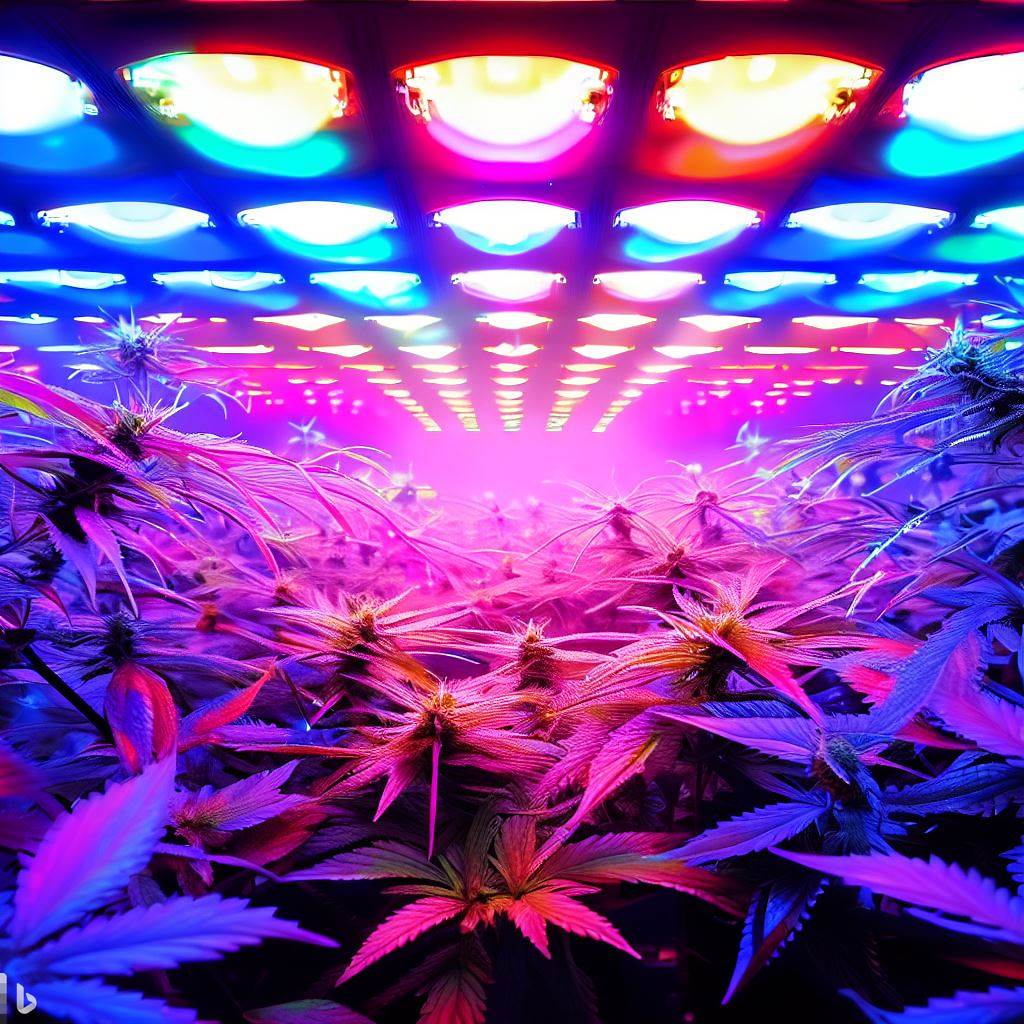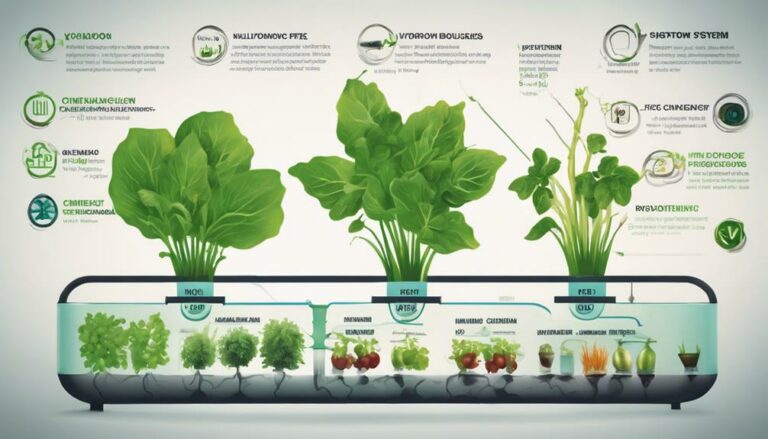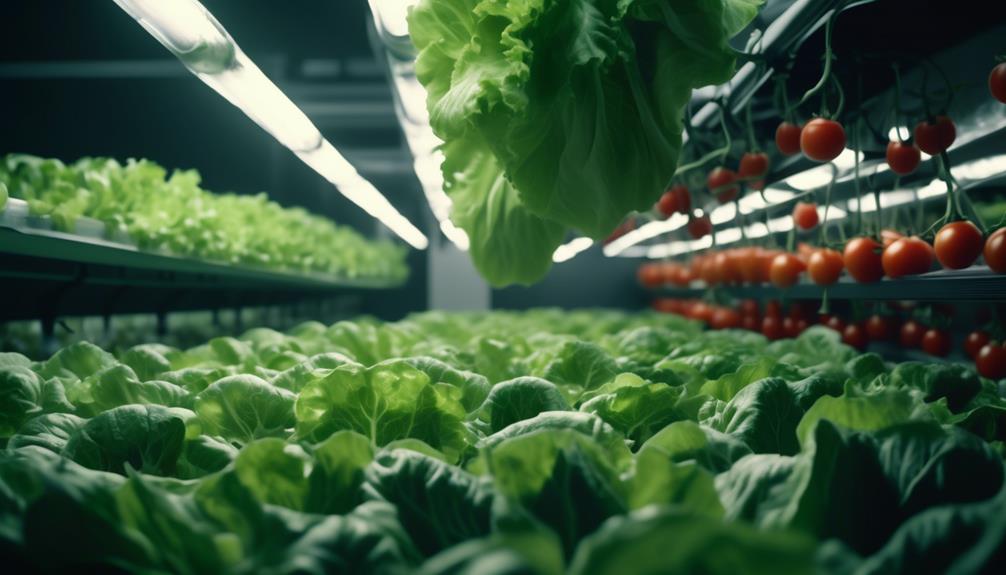Table of Contents
I have often wondered whether grow lights are bad for our eyes. After all, the light emitted by these lights is much more intense than natural sunlight, and we are often in close proximity to them for extended periods of time. In this article, I will explore the impact of grow lights on eye health, and offer some tips on how to protect your eyes while using them.
Introduction
If you are a hydroponics enthusiast, you probably use grow lights to provide artificial light for your plants. Grow lights are a great way to optimize the growth and yield of your plants, but they can also have a negative impact on your eye health. In this article, we will explore how grow lights affect your eyes, and what you can do to protect yourself from potential damage.
Nearly 75% of indoor horticulturists now employ LED grow lights for their energy efficiency and plant yield benefits. However, concerns regarding ocular health persist.
This article meticulously examines the potential eye damage caused by LED grow lights, integrating clinical evidence and expert opinions. We assess the risks of intense light exposure and provide actionable advice on protective measures, ensuring those who serve the horticultural community can do so without compromising their visual health.
Key Takeaways
- Prolonged exposure to LED grow lights, especially those emitting UV-A and UV-B light, can cause eye damage or discomfort.
- Precautions such as wearing protective eyewear and using lower intensity bulbs are recommended to prevent eye damage.
- LED grow lights, particularly those with a lot of blue and UV diodes, can disrupt sleep cycles and melatonin secretion.
- UV light emitted by LED grow lights can lead to vision loss, cataracts, macular degeneration, and other age-related vision problems.
Using LED Grow Lights: Advantages and Techniques
LED grow lights offer considerable benefits over traditional lighting methods. These benefits include enhanced energy efficiency and a longer operational lifespan. Additionally, LED grow lights provide the ability to fine-tune the light spectrum. This means that the spectrum can be optimized to support various stages of plant growth, from vegetative to flowering.
To maximize plant yield and health while minimizing potential risks to human eyes, it is crucial to employ strategic techniques in the use of LED grow lights.
Why Choose LED Over Traditional Lighting Methods
Commonly favored for their superior energy efficiency, LED grow lights present a significant advancement over traditional lighting methods in agricultural practices. The use of LED grow lights reflects a commitment to both environmental sustainability and economic prudence, with LED fixtures typically consuming less power and having longer lifespans than conventional options. Additionally, modern LED technology offers a spectrum of light tailored to the photosynthetic needs of plants, thereby enhancing growth and yield.
While LED grow lights are generally safer for your eyes compared to older high-intensity discharge (HID) lamps, it is important to acknowledge that prolonged exposure can cause damage. Techniques to mitigate risks include using appropriate protective eyewear and limiting time spent under intense light. These precautions ensure the well-being of individuals dedicated to agricultural care and productivity.
Optimizing LED Lighting for Plant Growth
Following the exploration of safety precautions, it’s pertinent to delve into how optimizing LED lighting can significantly enhance plant growth by utilizing the full spectrum of light that these advanced fixtures offer. The use of LED grow lights is pivotal for indoor horticulture, providing a tailored light spectrum that supports photosynthesis and plant vitality. Through precise control over the intensity and duration of exposure, growers can create an ideal environment for plant growth.
| Benefits of LED Grow Lights | Emotional Response |
|---|---|
| Energy Efficiency | Peace of Mind |
| Longevity | Trust in Investment |
| Full Spectrum Capabilities | Hope for Yield |
| Customizable Settings | Control in Care |
| Promotes Photosynthesis | Joy in Harvest |
Overview of Grow Lights and Their Use in Indoor Gardening
Grow lights are artificial light sources used to stimulate plant growth in indoor settings. They are commonly used by indoor gardeners to provide plants with the light they need to thrive, especially in locations where natural sunlight is not readily available. Grow lights are available in various sizes and types, including fluorescent, LED, and high-intensity discharge (HID) lights.
Importance of Considering Eye Safety When Using Grow Lights
While grow lights are an excellent way to promote healthy plant growth, it is important to consider the safety of our eyes when using them. Grow lights emit various types of light that can be harmful to the eyes, especially when exposure is prolonged or without proper eye protection.
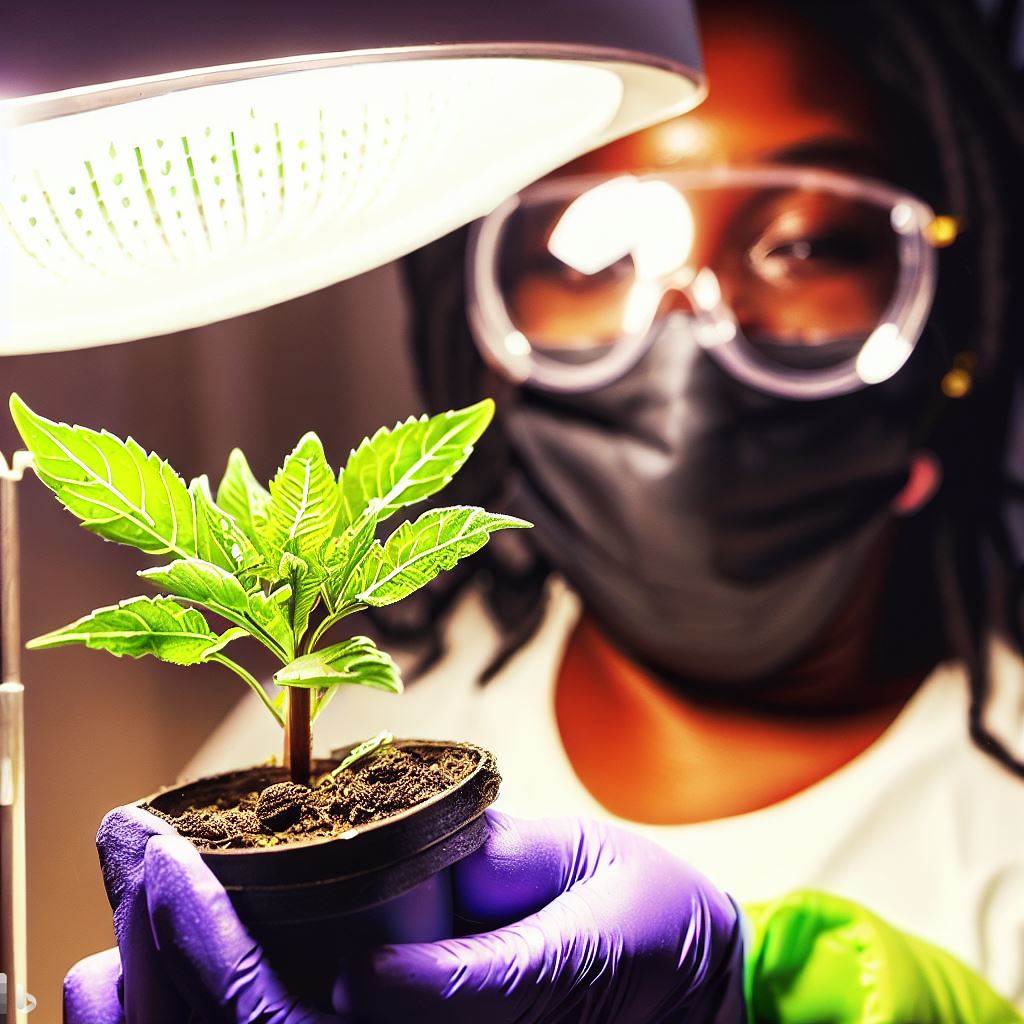
LED Grow Light: Enhancing Your Grow Room with Modern Technology
Incorporating LED grow lights into a grow room necessitates a precise balance between light intensity and coverage to optimize plant growth while mitigating risks to human health.
Proper configuration and positioning of LED lights are critical in providing uniform light distribution, which is essential for the consistent development of plants.
It is important to adhere to manufacturer recommendations and empirical research to ensure that the light environment is conducive to plant health without compromising the safety of individuals exposed to the light.
Setting Up LED Lights in a Grow Room
Optimization of plant growth in a controlled environment necessitates the strategic setup of LED grow lights to ensure both efficiency and safety.
When configuring a grow room, the placement of each LED light fixture must be calculated to provide uniform light exposure while minimizing the risk of eye damage to workers.
It is imperative to employ eye protection strategies, such as protective goggles that shield against harmful wavelengths emitted by LED grow lights.
The installation should be designed to prevent direct eye contact with the lights, and the intensity should be adjustable to cater to both plant needs and human safety.
Detail-oriented planning and adherence to safety guidelines are critical in establishing a grow room that prioritizes the well-being of plants and people alike.
Balancing Light Intensity and Coverage
Amidst the strategic setup of LED grow lights in a grow room, achieving the ideal balance between light intensity and coverage is crucial for plant health without compromising human eye safety. Proper management of these factors is essential to mitigate the risk of eye damage from LED grow, which can be dangerous to the human eye, particularly with respect to UV and blue light emissions.
Employing grow glasses designed for horticultural environments can protect against harmful rays, while simultaneously allowing for the accurate assessment of plant health and light distribution.
Careful adjustment and positioning of LED fixtures ensure that light intensity meets the photosynthetic needs of plants without creating hotspots or areas of excessive exposure that could pose a threat to eyesight.
Grow Room: Creating an Ideal Environment for Plant Growth
In fostering optimal plant growth within a grow room, controlling environmental parameters such as temperature and humidity is crucial.
Ventilation systems and strategic air circulation are key components that not only regulate these conditions but also mitigate potential plant stressors that can arise from stagnant air.
Implementing these measures effectively can result in a thriving indoor garden, minimizing the risk of plant diseases while enhancing overall growth and yield.
Managing Temperature and Humidity
How do temperature and humidity levels within a grow room impact the health of plants and the effectiveness of LED grow lights in promoting optimal growth?
Managing temperature and humidity is critical for ensuring that plants thrive under LED grow lights. Temperature regulation affects metabolic rates and enzymatic reactions in plants, while proper humidity levels are crucial for photosynthesis and transpiration processes.
Excessive heat can mitigate the benefits of using LED grow lights, potentially causing plant stress and evapotranspiration imbalance. Conversely, high humidity may foster fungal growth.
For the well-being of both plants and human eyes, since light can damage sensitive tissues, it is essential to maintain a balanced grow room environment. This holistic approach safeguards plant health and minimizes the risks associated with LED grow light exposure.
Ventilation and Air Circulation Strategies
To complement the management of temperature and humidity, effective ventilation and air circulation strategies are indispensable in a grow room to create an ideal environment for plant growth and to dissipate potentially harmful heat and light intensity from LED grow lights.
The use of LED lights, while advantageous for plant cultivation, requires awareness of their heat output and spectral emissions, including blue and UV light, which can be harmful to human eyes.
Implementing robust ventilation and air circulation strategies mitigates these risks by ensuring a steady exchange of air, reducing heat accumulation, and maintaining consistent light distribution.
Careful planning of these systems contributes to safeguarding both plant health and the ocular well-being of those tending to the grow room, thereby supporting a sustainable growth operation.
HPS Grow Lights: Understanding High-Pressure Sodium Lighting
High-pressure sodium (HPS) grow lights have long been a staple in the horticultural industry, prized for their efficiency in delivering the wavelengths conducive to plant growth and flowering.
When evaluating HPS against emerging LED technology, one must consider factors such as energy consumption, light spectrum, and thermal output, all of which can impact plant health and cultivation practices.
It is essential to analyze the implications of HPS lighting not only for plant yield but also for the potential ocular risks they pose to humans in comparison to LED alternatives.
The Role of HPS in Plant Cultivation
While LED grow lights are prevalent in indoor horticulture, High-Pressure Sodium (HPS) lamps remain a significant choice for plant cultivation due to their efficient output in the red-orange spectrum, which is highly beneficial for flowering and fruiting stages of plant growth.
These powerful grow lights have a reputation for their robustness and high luminous efficacy. The HPS light spectrum closely mimics the hues of the setting sun, a natural signal for many plants to produce flowers and fruits. Consequently, HPS grow lights are favored for their ability to stimulate phytohormones that influence these critical developmental phases.
Despite the rise of LEDs, sodium lights continue to be indispensable in certain cultivation scenarios, offering a proven and reliable lighting solution to support optimal plant health and yield.
Comparing HPS with LED Lighting
When comparing the characteristics of High-Pressure Sodium (HPS) lighting with LED grow lights, it is essential to consider both their spectral output and energy efficiency implications for plant cultivation and human eye safety.
HPS lights emit a warm spectrum with less blue light, which is beneficial for plant growth during the flowering phase but may be less efficient than LEDs.
LED fixtures, composed of multiple diodes, can provide a full spectrum, including a significant amount of blue light, which is important for vegetative growth. However, this amount of blue light could pose risks to human eyes if proper precautions are not taken.
Use LED: Advantages of LED Lighting in Horticulture
LED lighting technology has revolutionized horticultural practices through its energy efficiency and longevity, significantly reducing operational costs and environmental impact over time.
The capacity to alter the spectral output of LEDs allows for tailored light recipes that can optimize plant growth, development, and yield.
These advantages underscore the importance of integrating LED lighting into modern agricultural systems while considering the implications for human health and safety.
Energy Efficiency and Longevity
Maximizing plant growth efficiency and operational longevity, LED grow lights stand as a superior choice for horticultural lighting due to their energy-saving capabilities and extended lifespan. The light emitted by LED grow lights is engineered to be highly effective and visible to the human eye, optimizing photosynthesis in plants while minimizing energy wastage.
- Energy Efficiency and Longevity:
- Less heat output, reducing cooling costs
- Lower energy consumption compared to traditional lighting systems
- Longevity reduces the frequency of bulb replacements
Spectrum Variability and Plant Response
Within the realm of horticultural lighting, the advent of LED technology has introduced a new paradigm in spectrum variability, allowing for precise manipulation of light to elicit targeted responses from plants. LEDs can be tailored to emit specific wavelengths, optimizing plant health and productivity while considering the potential impact on the human eye. For instance, the amount of blue light emitted from blue and UV diodes can be controlled to mitigate risks to vision while enhancing vegetative growth.
| Spectrum Component | Impact on Plants | Consideration for Human Eye |
|---|---|---|
| Blue Light | Promotes vegetative growth | High-energy, potentially damaging |
| Red Light | Stimulates flowering | Generally safer for eyes |
| UV Diodes | Enhances plant defense | Can cause eye damage |
| Intensity Control | Adjusts to plant growth stages | Reduces risk of eye strain |
| Full Spectrum | Mimics natural sunlight | Can influence circadian rhythm |
This evidence-based approach ensures a balance between horticultural efficacy and ocular health.
UV Radiation: Its Role and Management in Grow Lighting
UV radiation, specifically in the form of UV-A and UV-B light, plays a critical role in simulating natural sunlight conditions that are conducive to plant growth and development.
However, the same UV rays have been associated with potential ocular hazards, including the acceleration of cataracts and the exacerbation of macular degeneration.
Consequently, it is imperative to implement protective measures such as specialized eyewear and controlled exposure durations to mitigate the risks associated with excessive UV exposure from LED grow lights.
Benefits of UV Light for Plant Growth
While LED grow lights have potential risks for human eyes, it’s important to acknowledge that certain wavelengths of UV light play a crucial role in plant growth and development.
- UV Radiation and Plant Health:
- Stress Response: UV light can trigger a protective response in plants, increasing their resilience against diseases.
- Improved Quality: Some plants develop enhanced flavors, colors, and nutrient profiles when exposed to ultraviolet light.
- Growth Regulation: UV radiation can regulate plant height and leaf size, contributing to more compact and robust growth.
Ensuring that grow lights are safe while providing the benefits of UV light for plant growth is pivotal. Although UV diodes can be harmful, with informed management, the use of ultraviolet light in horticulture can be optimized without compromising human health.
Safeguarding Against Excessive UV Exposure
Amid the widespread use of LED grow lights, it is imperative to implement strategies to protect against overexposure to UV radiation, a component known to have detrimental effects on human health. Ultraviolet (UV) light emitted from LED grow lights can damage your eyes and, with long periods of time, may also cause skin conditions.
Professionals should emphasize safeguarding against excessive UV exposure by advocating for the use of protective eyewear specifically designed to filter out harmful UV rays. Additionally, limiting the duration of exposure and maintaining a safe distance from the light source can further mitigate the risk.
Eye Damage from LED Grow: Understanding the Risks
LED grow lights are integral to indoor horticulture but may pose risks to eye health if proper precautions are not taken. Exposure to the blue light and UV radiation they emit has been linked to potential eye damage, including macular degeneration and cataract formation.
It is crucial for individuals utilizing these lights to be aware of the early signs of eye strain and to implement protective measures to mitigate these risks.
How LED Lights Affect Eye Health
Exposure to LED grow lights, particularly those emitting high levels of blue and ultraviolet light, poses a significant risk of eye damage, including conditions like macular degeneration and cataract formation. The mechanisms of harm include:
- Blue light exposure:
- Penetrates the retina, potentially causing irreversible damage.
- Disrupts circadian rhythms, affecting sleep and overall health.
- Effects of LED on human eyes and skin:
- Can lead to premature aging and skin cancer with prolonged exposure.
- Protective measures are crucial for those working in proximity to LED grow lights.
- Damage from LED grow lights:
- May result in conditions that compromise vision quality and eye health.
- Necessitates the use of protective eyewear to mitigate risk.
Considering these risks, it is imperative to implement safety protocols and educate those involved in the cultivation process about the importance of eye protection.
Recognizing Early Signs of Eye Strain
While working with LED grow lights, it is crucial to recognize early signs of eye strain, such as persistent headaches, blurred vision, or eye fatigue, as they may indicate the onset of potential eye damage related to ultraviolet and blue light exposure.
Those experiencing discomfort may question, ‘Can LED grow lights hurt my eyes?’ The answer is that, without proper precautions, there is a risk. Exposure to blue light, in particular, has been associated with retinal changes akin to macular degeneration.
To serve our community’s health, it is pivotal to acknowledge these symptoms promptly. Emphasizing the importance of protective measures can mitigate the potential damage from LED grow lights, safeguarding ocular health while nurturing plant growth.
Damage from LED Grow Lights: A Closer Look
Exploring the potential ocular hazards associated with LED grow lights requires an examination of the long-term impacts on vision.
Empirical studies suggest that exposure to certain wavelengths, particularly blue and ultraviolet, may accelerate conditions like macular degeneration and cataract formation.
Consequently, it is crucial to implement preventative measures and adhere to best practices, including the use of protective eyewear, to mitigate such risks for individuals frequently utilizing these lighting systems.
Long-Term Impacts on Vision
The long-term impacts on an individual’s vision from LED grow lights warrant careful consideration due to their potential to cause serious eye damage. Exposure to high-intensity LEDs, especially those that emit a lot of blue light, can lead to:
- Retinal Changes
- Macular degeneration from blue light at night
- Irreparable damage to photosensitive cells
- Cumulative effect leading to vision impairment
Circadian Rhythm Disruptions
- Sleep disturbances due to lot of blue light exposure
- Impaired melatonin production affecting overall health
Corneal and Lens Damage
- UV light can be harmful and cause cataracts
- Permanent alterations in corneal structure from intense light sources
- Increased risk of developing eye diseases with prolonged exposure
It is crucial to implement protective measures against potential damage led lights can inflict over time.
Preventative Measures and Best Practices
Frequently, the best defense against the damaging effects of LED grow lights on the eyes is the adoption of preventative measures and implementation of best practices. The blue light and UV emitted by LED grow lights can be detrimental, particularly to the delicate structures within the eyes if you look directly into the lights.
Compelling evidence suggests that certain wavelengths of light, especially those at the blue end of the spectrum, have the potential to cause retinal damage. As individuals committed to the care of others and ourselves, it is paramount to adhere to protective strategies.
Utilizing specialized eyewear designed to filter out harmful rays, positioning oneself at a safe distance from the light source, and minimizing direct ocular exposure are pivotal steps in safeguarding ocular health.
Lights Bad for Your Eyes: Debunking Myths and Understanding Facts
When considering the impact of LED grow lights on ocular health, it is crucial to differentiate between various types of light and their safety profiles. Recent ophthalmological studies provide empirical data regarding the potential risks of prolonged exposure to certain wavelengths, particularly in the blue and ultraviolet spectrums.
Armed with this knowledge, individuals can make informed decisions about eye protection and minimize the risk of retinal damage and other vision-related issues.
Differentiating Between Light Types and Eye Safety
Several types of light, particularly blue and ultraviolet (UV) rays, pose notable risks for eye safety and require careful consideration when working with LED grow lights. Understanding the spectrum and intensity of light is crucial in mitigating these risks:
- LED Grow Lights:
- Use a spectrum that can include intense blue light and UV light
- May cause eye damage with prolonged exposure without proper protection
- Require the use of protective eyewear designed to filter harmful wavelengths
- White Light:
- Perceived as less harmful but can still contain damaging blue light
- High-intensity white LED lights can contribute to digital eye strain
- UV Light:
- Includes UV-A and UV-B rays, which can lead to conditions like cataracts
- Necessitates strict safety measures, such as UV-blocking goggles
Protecting eyes from the potential hazards of LED grow lights involves understanding these distinctions and implementing evidence-based safeguards.
Insights from Ophthalmological Studies
Investigating the impacts of LED grow lights on ocular health, ophthalmological studies provide critical insights into the balance between myths and medically substantiated facts. These studies meticulously examine the influence of blue light and UV light emitted by LED grow lights, determining the potential for eye damage. By doing so, they debunk common misconceptions and deliver evidence-based recommendations for safe usage.
| Factor | Insight from Studies |
|---|---|
| Blue Light | Can cause retinal cell damage and affect sleep cycles |
| UV Light | May lead to cataracts and macular degeneration |
| Exposure | Prolonged contact heightens risk of eye damage |
| Protective Gear | Essential to shield eyes from harmful rays |
| Safe Practices | Include minimizing exposure time and maintaining distance |
These findings underscore the need for protective measures, such as specialized eyewear, to prevent harm while benefiting from LED grow lights.
Eye Protection: Essential Safety Gear for Grow Rooms
In indoor horticultural environments, where LED grow lights are prevalent, the necessity for protective eyewear is paramount to safeguard ocular health. Selecting the appropriate eye protection involves understanding the specific wavelengths emitted by LED lights and ensuring the eyewear effectively filters out harmful UV and blue light.
Implementing stringent safety protocols, including regular use of this safety gear, is crucial to prevent both acute and cumulative eye damage in individuals exposed to these artificial light sources.
Choosing the Right Eye Protection
Regularly selecting appropriate eye protection is crucial for safeguarding vision against the potential hazards posed by LED grow lights in cultivation environments. Cultivators must be equipped with safety gear that can effectively filter out harmful wavelengths, particularly blue light and UV light.
Types of Protective Eyewear:
- Glasses that block UV radiation
- Goggles designed to reduce blue light exposure
- Wrap-around shields for comprehensive protection
The ideal eyewear should offer comfort without compromising on safety, ensuring that individuals who serve in these settings are not at risk of eye damage.
LED grow lights, while they emit a cooler spectrum, still necessitate the use of protective glasses or goggles that can absorb or deflect the potentially harmful rays.
Implementing Regular Safety Protocols
Consistently implementing safety protocols is critical in ensuring that personnel in grow rooms are adequately protected from potential eye hazards associated with LED grow lights. High-pressure sodium (HPS) lights and LEDs that emit a cooler spectrum are less likely to cause harm than those with high levels of blue and UV light. However, it is vital to recognize that prolonged exposure to UV and blue light can lead to serious ocular issues and even skin cancer.
Therefore, adopting rigorous safety measures, including the use of appropriate eye protection, is essential. Grow room workers should be equipped with safety glasses or goggles designed to filter out harmful rays, thereby minimizing the risk of retinal damage and cataracts. Regular training and reminders can reinforce the importance of these safety practices.
How Grow Lights Affect Your Eyes
Types of Light Emitted by Grow Lights
Grow lights emit three types of light: blue, UV, and infrared. Blue light is the most important for plant growth, but it is also the most harmful to the eyes. UV light is also harmful to the eyes, and can cause damage to the cornea and lens. Infrared light, while not harmful to the eyes, can cause heat buildup that can damage plants if not properly managed.
The Impact of Blue Light on Your Eyes
Blue light is a type of visible light that has a short wavelength and high energy. It is emitted by the sun, as well as by artificial sources such as LED lights, digital screens, and fluorescent bulbs. While blue light has some benefits, such as boosting alertness, mood, and cognitive function, it can also have negative effects on your eyes. Exposure to excessive or prolonged blue light can cause eye strain, dryness, irritation, and headaches. It can also damage the retina, the light-sensitive tissue at the back of the eye, and increase the risk of age-related macular degeneration, cataracts, and eye cancer. To protect your eyes from blue light, you should wear sunglasses or special glasses that block or filter out blue light when outdoors or using digital devices. You should also limit your screen time, especially before bedtime, as blue light can disrupt your sleep cycle. You should also get regular eye exams to check your eye health and vision. By following these tips, you can enjoy the benefits of blue light without compromising your eye health.
The Impact of UV Light on Your Eyes
UV light is invisible to the naked eye, but it can still cause eye damage. Exposure to UV light can cause photokeratitis, a painful condition that can cause temporary vision loss. Prolonged exposure can also increase the risk of cataracts and other eye diseases.
UV light is a type of electromagnetic radiation that has a shorter wavelength and higher energy than visible light. It is emitted by the sun, as well as by artificial sources such as tanning beds, welding machines, and lasers. While UV light has some benefits, such as stimulating vitamin D production and killing bacteria, it can also have harmful effects on your eyes. Exposure to excessive or prolonged UV light can cause:
- Eye strain: UV light can cause eye strain, which is a condition that occurs when your eyes get tired from intense or prolonged use. Eye strain can cause symptoms such as dryness, irritation, redness, burning, itching, blurred vision, headache, or fatigue.
- Photokeratitis: UV light can cause photokeratitis, which is a type of sunburn of the cornea. The cornea is the clear front layer of the eye that protects the iris and lens. Photokeratitis can cause symptoms such as pain, sensitivity to light, tearing, swelling, or temporary vision loss.
- Cataracts: UV light can cause cataracts, which are cloudy areas that form in the lens of the eye. The lens is the transparent structure that focuses light onto the retina. Cataracts can cause symptoms such as blurred vision, glare, halos, or reduced color perception.
- Macular degeneration: UV light can cause macular degeneration, which is a progressive disease that affects the macula. The macula is the central part of the retina that is responsible for sharp and detailed vision. Macular degeneration can cause symptoms such as distorted vision, dark spots, or loss of central vision.
- Eye cancer: UV light can cause eye cancer, which is a rare but serious condition that affects the tissues of the eye. Eye cancer can cause symptoms such as changes in vision, eye pain, redness, swelling, or abnormal growths.
To ensure the protection of your eyes from UV light, actively wear sunglasses or specialized glasses that effectively block or filter out UV rays whenever you are outdoors or using artificial light sources. Take proactive measures to limit your exposure time and avoid direct eye contact with the sun or other sources of intense brightness. Regularly schedule eye exams to monitor your eye health and vision. By actively following these tips, you can effectively prevent or minimize the damage caused by UV light to your eyes.
The Impact of Infrared Light on Your Eyes
Infrared light is a type of electromagnetic radiation that has a longer wavelength and lower energy than visible light. It is emitted by the sun, as well as by artificial sources such as heaters, lasers, and infrared cameras. While infrared light has some benefits, such as stimulating blood circulation, healing wounds, and relieving pain, it can also have harmful effects on your eyes. Exposure to excessive or prolonged infrared light can cause:
- Eye strain: Infrared light can cause eye strain, which is a condition that occurs when your eyes get tired from intense or prolonged use. Eye strain can cause symptoms such as dryness, irritation, redness, burning, itching, blurred vision, headache, or fatigue.
- Thermal injury: Infrared light can cause thermal injury, which is a type of burn that affects the cornea and the lens. The cornea is the clear front layer of the eye that protects the iris and lens. The lens is the transparent structure that focuses light onto the retina. Thermal injury can cause symptoms such as pain, sensitivity to light, tearing, swelling, or permanent vision loss.
- Cataracts: Infrared light can cause cataracts, which are cloudy areas that form in the lens of the eye. The lens is the transparent structure that focuses light onto the retina. Cataracts can cause symptoms such as blurred vision, glare, halos, or reduced color perception.
- Retinal damage: Infrared light can cause retinal damage, which is a condition that affects the retina. The retina is the light-sensitive tissue at the back of the eye that converts light into nerve signals. Retinal damage can cause symptoms such as blind spots, flashes, floaters, or vision loss.
In order to shield your eyes from infrared light, it is important to utilize sunglasses or specialized glasses specifically designed to block or filter out infrared rays whenever you are outdoors or exposed to artificial light sources. Take proactive steps to minimize your exposure time and refrain from directly staring at the sun or any other intense light sources. Additionally, make sure to schedule regular eye examinations to assess your eye health and vision. By adhering to these guidelines, you can effectively prevent or diminish the potential harm inflicted on your eyes by infrared light.
Risks of Grow Lights to Eye Health
Eye Strain and Fatigue
Exposure to intense light for prolonged periods of time can cause eye strain and fatigue. This is especially true for those who work under grow lights for extended periods of time, such as indoor gardeners. Symptoms of eye strain and fatigue include dry eyes, blurred vision, and headaches.
Photokeratitis
Photokeratitis is a painful condition that occurs when the cornea is exposed to high levels of UV light. Symptoms include eye pain, tearing, and sensitivity to light. This condition is often referred to as “snow blindness” because it is commonly caused by exposure to sunlight reflected off of snow.
Macular Degeneration
Macular degeneration is a leading cause of vision loss in older adults. Prolonged exposure to blue light can increase the risk of developing this condition. Symptoms include blurred vision, dark or empty spots in the center of vision, and distorted vision.
Ways to Protect Your Eyes While Using Grow Lights
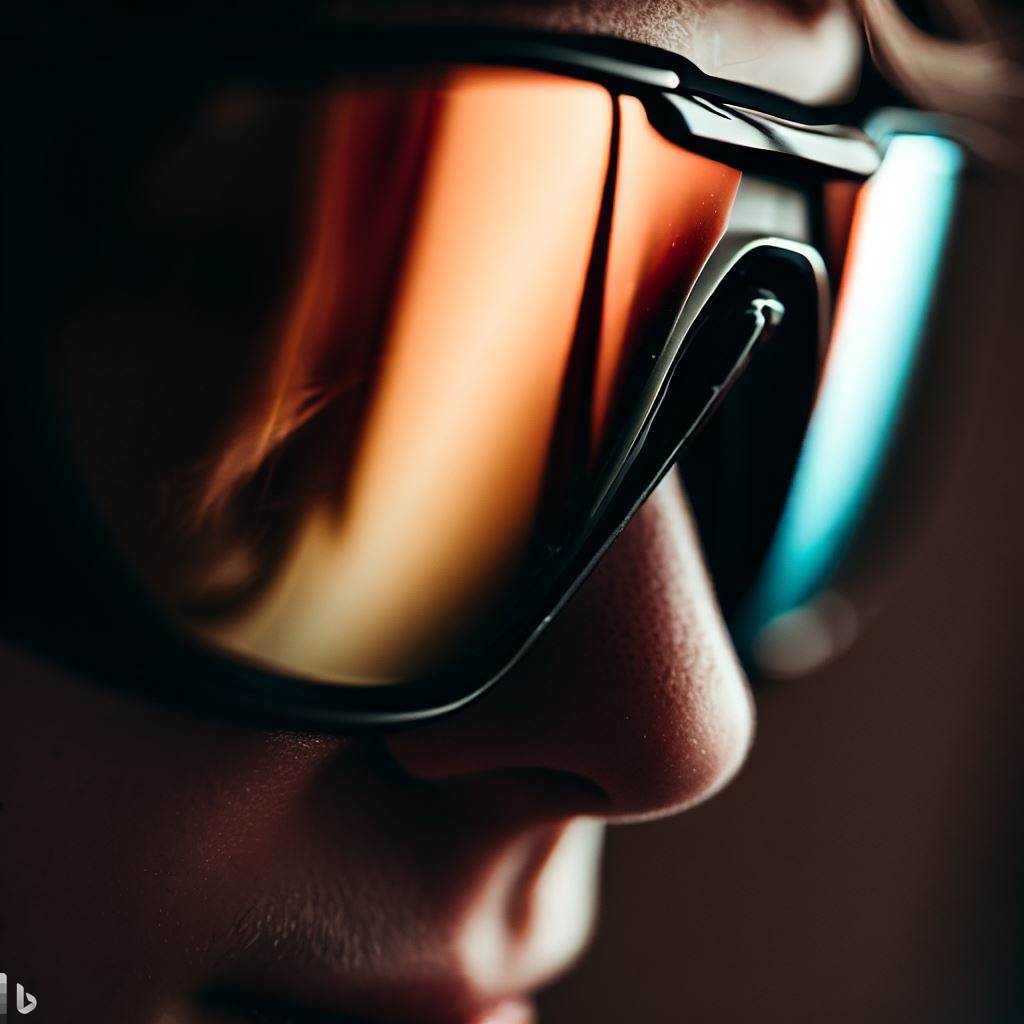
Using Proper Eyewear
The best way to protect your eyes while using grow lights is to wear specialized eyewear designed to block harmful light. These glasses are available online or at gardening supply stores and are specifically designed to protect the eyes from the types of light emitted by grow lights.
Limiting Exposure Time
Limiting exposure time to grow lights is another effective way to protect your eyes. Indoor gardeners should take frequent breaks and avoid working under grow lights for extended periods of time.
Keeping a Safe Distance from the Light Source
Keeping a safe distance between yourself and the grow lights is also important for eye safety. Experts recommend maintaining a distance of at least 2 feet from the light source.
Choosing the Right Grow Light for Your Needs
Choosing the right grow light for your needs is another way to protect your eyes. Some grow lights emit less harmful light than others, and choosing a grow light that emits less harmful light can help reduce the risk of eye damage.
Conclusion
In conclusion, grow lights can be an excellent way to promote healthy plant growth in indoor settings. However, it is important to consider the impact of grow lights on eye health, and take steps to protect our eyes while using them. By wearing proper eyewear, limiting exposure time, keeping a safe distance from the light source, and choosing the right grow light for your needs, indoor gardeners can enjoy the benefits of grow lights without compromising their eye health.
Grow lights are a useful tool for hydroponics enthusiasts, but they can also pose a risk for your eye health. Grow lights emit bright and intense light that is rich in blue and UV wavelengths, which can cause eye strain, photokeratitis, macular degeneration, or cataracts. To protect your eyes from grow lights, you should wear protective eyewear, adjust the distance and angle of the lights, take breaks from using them, and get regular eye exams. By following these tips, you can enjoy the benefits of grow lights without compromising your eye health.
FAQs
How long can I be exposed to grow lights without damaging my eyes?
It is recommended to limit exposure time to grow lights to no more than 12 hours per day. However, it is important to take frequent breaks and avoid working under grow lights for extended periods of time.
Can I use regular sunglasses instead of specialized eyewear?
No, regular sunglasses are not effective at blocking the types of light emitted by grow lights. It is important to wear specialized eyewear designed to protect the eyes from the types of light emitted by grow lights.
Do all types of grow lights emit harmful light?
No, not all types of grow lights emit harmful light. LED grow lights, for example, emit less harmful light than other types of grow lights.
Is it safe to use grow lights in a room where people spend a lot of time?
Yes, it is safe to use grow lights in a room where people spend a lot of time. However, it is important to take steps to protect the eyes from the types of light emitted by grow lights.
Can grow lights cause permanent eye damage?
Prolonged exposure to the types of light emitted by growlights can increase the risk of eye damage, including permanent eye damage such as macular degeneration. It is important to take steps to protect your eyes while using grow lights to minimize the risk of eye damage.
How Do the Wavelengths of LED Grow Lights Compare to the Wavelengths of Natural Sunlight in Terms of Potential Eye Damage?
LED grow lights emit wavelengths similar to natural sunlight, including potentially harmful UV and blue light, which can cause eye damage without proper protection or exposure management. Use of protective eyewear is advised.
Can the Nutritional Value of Plants Grown Under LED Grow Lights Be Affected if the Lights Are Improperly Calibrated?
Plants cultivated under improperly calibrated LED grow lights may exhibit altered nutritional profiles, necessitating precise adjustments to ensure optimal growth conditions and health benefits for consumers relying on these indoor-grown crops.
Are There Any Long-Term Studies on the Effects of Daily Exposure to LED Grow Lights on Eye Health Among Professional Horticulturists?
Long-term studies on the ocular impacts of daily LED grow light exposure in horticulturists are limited, necessitating further research to understand potential risks and establish appropriate protective measures.
How Does the Risk of Eye Damage From LED Grow Lights Vary Across Different Age Groups and Those With Pre-Existing Eye Conditions?
“Prevention is better than cure,” especially when considering ocular health. Risks of eye damage from LED grow lights heighten with age and for those with underlying eye conditions, necessitating stringent protective measures.
Can the Use of LED Grow Lights Lead to Any Psychological Effects, Such as Seasonal Affective Disorder (Sad), Due to Altered Light Exposure Patterns?
LED grow lights may affect circadian rhythms, potentially exacerbating conditions like Seasonal Affective Disorder (SAD) due to unnatural light exposure patterns, necessitating careful monitoring of usage to mitigate psychological impacts.
